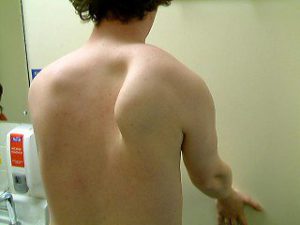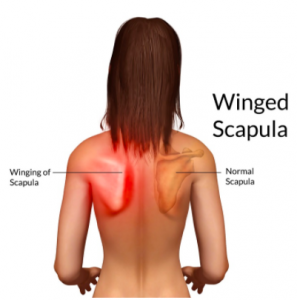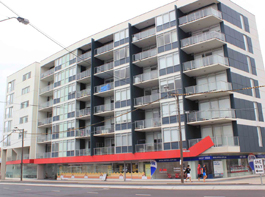What is scapula winging?
Scapula winging is when the borders of the scapula (shoulder blade) stick out away from the ribcage. Normally the scapula is meant to lie flat against the rib-cage. Scapula winging usually results from muscle imbalances of the muscles attaching to the scapula. Imbalances commonly occur between the pectoralis minor, upper trapezius, lower trapezius and serratus anterior muscles.
Educate on the topic
- Shoulder blade sticking out is also what we call scapular winging
- It is cause by long standing weakness of your shoulder blade muscles
- Some people can have shoulder blade winging without pain, some may be with pain
- Whether you are experiencing pain or not with this issue is definitely something you want to fix because it puts you at a very high risk of having shoulder injuries.
Scapular winging
- Our shoulder blades act as a stable base for all of our shoulder movement.
- Without proper shoulder blade control you will also have poor shoulder control
- Leading to
- Reduce shoulder strength
- Slowing down of plateauing in shoulder strength progression in your training
- Increase risk of shoulder injuries
- Reduce your shoulder overall performance

Consequences of scapula winging:
Scapula winging can result in inefficient movement of the glenohumeral (shoulder) joint. The scapula and shoulder joint are connected. If the resting position and movements of the scapula are not in optimum position, it can lead to restricted movements of the shoulder joint. This in turn can lead to impingement of the rotator cuff tendons and associated pain and dysfunction.
Weakness of the cervicothoracic postural muscles and subsequent scapula winging can also lead cause increased tension and pain in the muscles between the shoulder blades and the muscles attaching from the scapula to the neck. This in turn can lead to joint stiffness and potentially tension-headaches in more severe cases.
 How can Capital Physiotherapy help reduce scapula winging?
How can Capital Physiotherapy help reduce scapula winging?
After thorough assessment to determine which muscles are contributing to the winging scapula, our physiotherapists may use a variety of different treatment to try and relieve symptoms associated with scapula winging and reduce the winging itself.
Treatment options include:
- Postural education and correction
- Postural taping
- Massage to relieve tension of tight muscles
- Dry needling to relieve muscle pain and tightness
- Muscle strengthening and re-training to correct muscle-imbalances causing the winging
- EMG activation prior to strengthening to help activate muscles that have difficulty firing due to altered neuromuscular activation patterns
Keeping in mind these exercises are of general nature and do not take your injuries/history into considerations. In order to fully rehab your shoulder blade discomfort you will still need to continue to progress to harder and more functional strengthening exercises that are specifically tailored for you, in order to feel pain free while working.


 With her wealth of clinical experience – in both public and private systems, Melanie is contactable at Capital Physiotherapy’s Hawthorn Physio clinic to provide you with the best physio treatment in the Hawthorn and for the surrounding suburbs.
With her wealth of clinical experience – in both public and private systems, Melanie is contactable at Capital Physiotherapy’s Hawthorn Physio clinic to provide you with the best physio treatment in the Hawthorn and for the surrounding suburbs.
